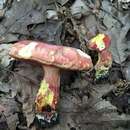fi
nimet breadcrumb-navigoinnissa


Boletus carminiporus is a species of bolete fungus in the family Boletaceae. Described as new to science in 1998, the species is found in the southern United States where it grows in a mycorrhizal association with various trees in mixed forests.
The species was first described scientifically by mycologists Alan Bessette, Ernst Both, and Dail Dunaway in 1998, based on collections made in Mississippi.[1]
Fruit bodies have caps that are initially convex before flattening out in maturity, attaining a diameter of 3–14 cm (1.2–5.5 in). The cap margin, initially curved or curled inward, uncurls slightly in age. The cap surface is dry to slightly sticky, and smooth. Young specimens are dull red, changing gradually to pinkish-red or orange-red in maturity. The flesh is whitish to pale yellow, but darkens slightly in age or when exposed to air. It has no distinctive taste or odor, and, unlike many bolete species, does not turn blue when cut or injured. The pore surface on the underside of the cap is yellow at first, but stains bluish green then dull olive when bruised. The angular to irregular pores number about 2–3 per millimeter, while the tubes comprising the hymenophore are 0.3–1.2 cm (0.1–0.5 in) deep. The stem is 5–11.5 cm (2.0–4.5 in) long by 1–3 cm (0.4–1.2 in) thick, and either the same width throughout its length or thicker near the base. It is solid (i.e., not hollow), dry, and marked by a reticulum (a network of raised ridges surface), especially on the upper portion. Initially rose-pink, in age the color deepens to red. The stems stains red or greenish when injured.[2]
Boletus carminiporus produces an olive-brown spore print. Spores are somewhat spindle-shaped, smooth, and measure 8–11 by 3–4 μm.[2] The edibility of the fruit bodies is unknown. They can be used in mushroom dyeing to produce greenish yellow, brownish yellow, brownish orange, or olive colors, depending on the mordant used.[3]
Species that share a somewhat similar appearance include Boletus flammans and Boletus rubroflammeus, but the mushrooms of these species stain blue when injured.[2]
Boletus carminiporus is a mycorrhizal fungus. Its fruit bodies grow singly, scattered, or in groups on the ground, typically near beech, hickory, and oak in mixed forests. Fruiting occurs from June to September. Known only from North America, its distribution extends from North Carolina south to Florida, and west to Arkansas and Louisiana.[2]
Boletus carminiporus is a species of bolete fungus in the family Boletaceae. Described as new to science in 1998, the species is found in the southern United States where it grows in a mycorrhizal association with various trees in mixed forests.
Boletus carminiporus es una especie de hongo boleto en la familia Boletaceae. Descrito como nueva para la ciencia en 1998, la especie se encuentra en el sur de Estados Unidos donde crece en una asociación micorrícica con árboles diversos en los bosques mixtos.
La especie fue descrita por primera vez científicamente por micólogos Alan Bessette, Ernst Both y Dunaway Dail en el año 1998, con base en las colectas hechas en Mississippi.[1]
Los cuerpos fructíferos tienen tapas que están inicialmente convexas antes de aplanarse en la madurez, alcanzando un diámetro de 3-14 cm (1.2 a 5.5 cm). El margen de la tapa, en un principio curvado o enrollado hacia adentro, de desencurva ligeramente con la edad. La superficie de la tapa es seca y ligeramente pegajoso y suave. Los ejemplares jóvenes son de color rojo opaco, cambiando gradualmente a rosado-rojo o rojo-anaranjado en la madurez. La carne es color blanquecina a amarillo pálido, pero se oscurece ligeramente con la edad o cuando se expone al aire. No tiene sabor ni olor característico, y a diferencia de muchas especies boleto, no se vuelve azul cuando se corta o se lastima.
La superficie de los poros en la parte inferior de la tapa es de color amarillo al principio, pero se mancha de verde azulado a oliva opaco cuando los poros se aplastan. Los poros, angulares irregulares, son de 2-3 por milímetro, mientras que los tubos que comprenden el himenóforo son 0.3-1.2 cm (0,1-0,5 pulgadas) de profundidad. El vástago es 5-11.5 cm (2,0-4,5 pulgadas) de largo por 3.1 cm (0.4 a 1.2) de espesor, y, o bien de la misma anchura en toda su longitud o más gruesa cerca de la base. Es sólida (es decir, no hueco), seca, y marcada por un retículo (una red de superficie de crestas levantadas), especialmente en la parte superior. Inicialmente rosado, con la edad, el color se profundiza a rojo. Los tallos se manchan de color rojo o verde cuando se lesionan.[2]
Boletus carminiporus es un hongo micorriza. Sus cuerpos frutales crecen solos, en grupos dispersos, o en el suelo, normalmente cerca de haya, nogal y roble en bosques mixtos. La fructificación se produce a desde junio hasta septiembre. Sólo se le conoce en América del Norte, su distribución se extiende desde el sur de Carolina del Norte hasta Florida, y al oeste de Arkansas y Louisiana.[2]
Boletus carminiporus es una especie de hongo boleto en la familia Boletaceae. Descrito como nueva para la ciencia en 1998, la especie se encuentra en el sur de Estados Unidos donde crece en una asociación micorrícica con árboles diversos en los bosques mixtos.